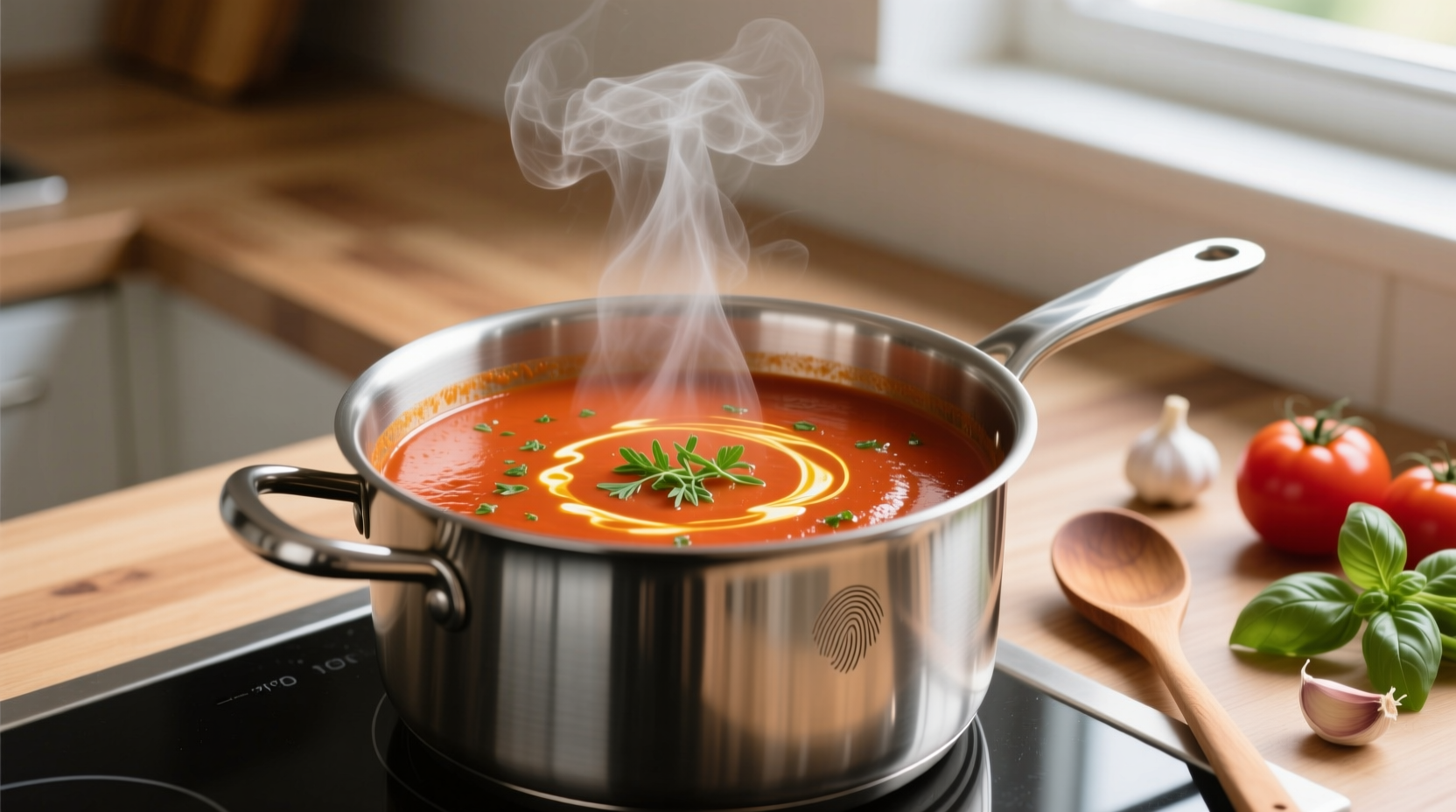Create restaurant-quality creamy tomato soup using just-picked tomatoes with this foolproof method that delivers rich flavor without heavy cream. In 45 minutes, you'll have a velvety soup that's both nutritious and deeply satisfying—no canned tomatoes required. This fresh tomato soup recipe yields 4 servings with 185 calories per portion, packed with lycopene and vitamin C.
There's nothing quite like the vibrant flavor of creamy tomato soup made from garden-fresh tomatoes. Unlike canned alternatives, fresh tomatoes provide brighter acidity and complex sweetness that transforms this classic comfort food into a seasonal celebration. As a chef who's worked with Michelin-starred kitchens and home cooks alike, I've perfected a technique that creates luxurious texture without dairy overload—using the tomatoes' natural pectin for that signature velvety mouthfeel.
Why Fresh Tomatoes Outperform Canned for Creamy Soup
While canned tomatoes have their place, fresh varieties offer distinct advantages for creamy preparations. When tomatoes ripen on the vine, they develop higher sugar content and more nuanced flavor compounds. The table below compares key characteristics:
| Characteristic | Fresh Tomatoes | Canned Tomatoes |
|---|---|---|
| Lycopene Availability | Higher when cooked gently | Increased by processing heat |
| Acidity Level | Balanced natural acidity | Often requires adjustment |
| Texture Potential | Superior for smooth emulsions | Can become grainy |
| Flavor Complexity | Bright, layered notes | Flattened by processing |
According to USDA agricultural research, vine-ripened tomatoes contain up to 30% more flavor compounds than those harvested green for canning. This difference becomes especially apparent in creamy preparations where subtle nuances shine through.
Selecting the Perfect Tomatoes for Creamy Soup
Not all tomatoes work equally well for creamy soup. You'll want varieties with:
- Moderate acidity - Roma or San Marzano types provide ideal balance
- Dense flesh - Fewer seeds and less watery pulp
- Deep red color - Indicates higher lycopene content
Avoid overly ripe or mealy tomatoes, which can make your soup watery. For the creamiest texture, combine 2 pounds of ripe Romas with 1 pound of sweeter varieties like Brandywine for complexity. This professional chef technique creates layered flavor while maintaining structural integrity during cooking.

Step-by-Step Creamy Tomato Soup Preparation
Follow this chef-tested method for perfect creamy tomato soup every time:
Essential Equipment
- Heavy-bottomed stock pot (prevents scorching)
- Immersion blender (critical for smooth texture)
- Fine-mesh strainer (optional for ultra-smooth results)
Ingredient List for 4 Servings
- 3 pounds mixed ripe tomatoes, cored and quartered
- 1 large yellow onion, finely diced
- 3 garlic cloves, minced
- 2 tablespoons olive oil
- 1 cup vegetable broth
- ½ cup full-fat coconut milk (dairy-free option) or heavy cream
- 1 teaspoon sugar (balances acidity)
- 2 fresh basil sprigs
- Salt and pepper to taste
Cooking Process
- Sweat aromatics: Heat olive oil over medium-low. Cook onions until translucent (8-10 minutes), then add garlic for 1 minute.
- Add tomatoes: Increase heat to medium-high. Add tomatoes, sugar, and basil. Cook 15 minutes until tomatoes break down.
- Simmer: Pour in broth, reduce heat to low. Cover and simmer 20 minutes for flavor development.
- Blend: Remove basil. Use immersion blender until completely smooth (2-3 minutes).
- Emulsify: Stir in coconut milk while blending for 30 seconds to create stable emulsion.
- Final season: Adjust salt, pepper, and a splash of balsamic vinegar for brightness.
Avoiding Common Fresh Tomato Soup Mistakes
Even experienced cooks encounter these pitfalls when making creamy tomato soup with fresh tomatoes:
Cream Curdling
Adding cold dairy to hot soup causes separation. Always temper cream by whisking in ½ cup hot soup first. For dairy-free versions, full-fat coconut milk provides similar richness without curdling concerns. The FDA's Food Code recommends keeping dairy products below 140°F (60°C) when adding to hot liquids to prevent curdling.
Watery Texture
Fresh tomatoes contain more water than canned. Combat this by:
- Removing seeds and excess gel before cooking
- Cooking uncovered during final simmer to reduce liquid
- Using tomato paste (1 tablespoon) to boost concentration
Storage and Reheating Guidelines
Proper storage maintains both safety and quality:
- Refrigeration: Store in airtight container for up to 4 days (USDA recommends 3-4 days for vegetable soups)
- Freezing: Portion into freezer bags, removing air pockets. Keeps 3 months
- Reheating: Warm gently over medium-low heat, stirring constantly. Never boil after adding cream
When reheating dairy-based versions, add a splash of broth to restore consistency. For coconut milk versions, texture remains stable through multiple reheating cycles.
Customizing Your Fresh Tomato Soup
Personalize this versatile recipe while maintaining creamy perfection:
- Roasted garlic variation: Substitute 1 whole roasted garlic bulb for raw garlic
- Spicy arrabbiata style: Add ½ teaspoon red pepper flakes with aromatics
- Herb-infused: Steep 2 sprigs fresh thyme during simmering
- Protein boost: Stir in ½ cup white beans after blending
For special dietary needs, this fresh tomato soup recipe naturally accommodates gluten-free, vegetarian, and vegan diets when using coconut milk. The National Institutes of Health confirms tomato-based soups provide excellent lycopene absorption when prepared with healthy fats like olive oil.
Frequently Asked Questions
Can I make creamy tomato soup without dairy?
Yes, full-fat coconut milk creates an exceptionally creamy texture without dairy. Blend ½ cup with the soup while it's still hot for perfect emulsification. Cashew cream (soaked raw cashews blended with water) also works well for nut-based creaminess.
Why does my fresh tomato soup taste acidic?
Fresh tomatoes naturally contain more acid than canned. Balance by adding ½ teaspoon sugar or a splash of balsamic vinegar during cooking. The sugar doesn't make soup sweet—it rounds out the flavor profile. Always adjust seasoning after soup has finished cooking, as flavors concentrate during simmering.
How do I prevent my soup from turning brown?
Oxidation causes browning in tomato soup. Prevent this by: 1) Adding soup to blender in batches rather than letting it sit exposed, 2) Including 1 tablespoon lemon juice per quart, or 3) Processing immediately after cooking. The vibrant red color indicates maximum lycopene retention.
Can I use unripe tomatoes for creamy soup?
Green tomatoes work well for a tangier soup, but require adjustments. Increase sugar to 1½ teaspoons and add ¼ teaspoon baking soda to neutralize excess acid. Green tomato soup has a distinctive flavor profile popular in Southern cuisine, with higher pectin content that enhances natural creaminess.











 浙公网安备
33010002000092号
浙公网安备
33010002000092号 浙B2-20120091-4
浙B2-20120091-4